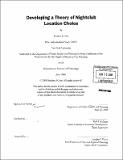Developing a theory of nightclub location choice
Author(s)
Crim, Stephen J. (Stephen Johnson)
DownloadFull printable version (21.13Mb)
Other Contributors
Massachusetts Institute of Technology. Dept. of Urban Studies and Planning.
Advisor
Karl F. Seidman.
Terms of use
Metadata
Show full item recordAbstract
This work is an investigation of the factors that influence where nightclubs locate within a city. Nightclubs, like other social spaces, provide important social and economic benefits in the urban environment. As amenities, they attract labor to cities, and as sites of social exchange, they provide space in which individuals can create the networks necessary for innovative industrial production, especially in the fine arts and other creative sectors. Nightclubs also appear to have a role in neighborhood upgrading or gentrification. Despite their importance, this is the first study on the factors that determine nightclub location choice. New York City and primarily Manhattan were chosen as sites for investigation because of the City's high number of nightclubs, and because of the regulatory as well as real estate pressures that are currently affecting the industry. A variety of sources, including personal interviews with nightclub owners and their employees, various government documents, as well as spatial and non-spatial databases, were consulted to formulate conclusions. As is the case with other forms of retail, nightclub owners are most concerned with patron accessibility and proximity to complimentary businesses when deciding where to locate their businesses. Other factors are also discussed, as is a theory of how super-regional nightclub clusters form. Not surprisingly, the author finds that nightclub location choice is highly constrained by the content, administration, and evolution of various city and state laws. Finally, recommendations designed to ease the regulatory burden on nightclubs while still controlling for nuisance concerns are presented for both government agencies and the industry.
Description
Thesis (M.C.P.)--Massachusetts Institute of Technology, Dept. of Urban Studies and Planning, 2008. Includes bibliographical references (p. 73-77).
Date issued
2008Department
Massachusetts Institute of Technology. Department of Urban Studies and PlanningPublisher
Massachusetts Institute of Technology
Keywords
Urban Studies and Planning.